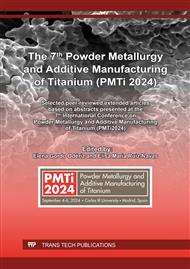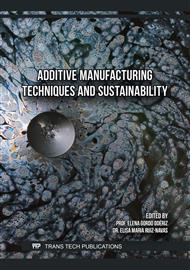p.3
p.13
p.23
p.29
p.41
p.49
p.59
p.69
Manufacturing of a Ti6Al4V Aerospace Component by Metallic Wire Based Laser Beam Directed Energy Deposition
Abstract:
Excellent properties of titanium alloys as the high strength-to-weight ratio and exceptional corrosion resistance result very attractive for the industry. However, the high manufacturing costs of conventional processing methods, as well as the material waste remain challenging making these alloys only accessible to sectors such as aerospace.Additive manufacturing (AM) becomes an attractive solution to manufacture titanium based high-added value components due to the rapid prototyping, complex geometries manufacturing and waste reduction. Specifically, Laser Beam Directed Energy Deposition based on Metal Wire (DED-LB/Mw) process is becoming a key manufacturing process, mainly due to higher deposition rate, ability to build larger structures and high material efficiency compared with other usual AM technologies, as powder bed fusion (PBF), or powder-based DED processes (DED-LB/Mp). However, there are some challenges to industrialise the AM printed titanium alloys due to their high reactivity with oxygen at high temperature and mechanical properties of the deposited material because of extremely high residual stresses (RRSS).This paper reports the work carried out to demonstrate the feasibility of coaxial DED-LB/Mw process to manufacture a semi-spherical part, with potential application in the aerospace sector as a fuel tank. The work has been focused in three key issues:The effect of the argon shielding environments has been evaluated on three different configurations (local, inert chamber, local + inert chamber) to bring a deep understanding on the influence of protective conditions on process stability, surface quality, metallurgy and microhardness.The DED-LB/Mw processing of Ti-6Al-4V alloy has been parametrized to achieve the optimum process parameters attending to deposition rate and process stability. Mechanical properties have been also assessed on samples manufactured under the acceptable atmosphere condition.The optimal manufacturing strategy, with the established process parameters and protective atmosphere conditions, has been selected to manufacture the semi-spherical part also considering the trajectory limitations imposed by the required working movement conditions within the chamber
Info:
Periodical:
Pages:
13-21
Citation:
Online since:
March 2025
Authors:
Price:
Сopyright:
© 2025 Trans Tech Publications Ltd. All Rights Reserved
Share:
Citation:



